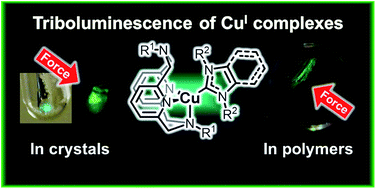Triboluminescence of a new family of CuI–NHC complexes in crystalline solid and in amorphous polymer films†
Abstract
Triboluminescent compounds that generate emission of light in response to mechanical stimulus are promising targets in the development of “smart materials” and damage sensors. Among triboluminescent metal complexes, rare-earth europium and terbium complexes are most widely used, while there is no systematic data on more readily available and inexpensive Cu complexes. We report a new family of photoluminescent Cu–NHC complexes that show bright triboluminescence (TL) in the crystal state visible in ambient indoor light under air. Moreover, when these complexes are blended into amorphous polymer films even at small concentrations, TL is easily observed. Observation of TL in polymer films overcomes the limitation of using crystals and opens up possibilities for the development of mechanoresponsive coatings and materials based on inexpensive metals such as Cu. Our results may also have implications for the understanding of the TL effect's origin in polymer films.

- This article is part of the themed collection: Celebrating 10 years of Chemical Science


 Please wait while we load your content...
Please wait while we load your content...